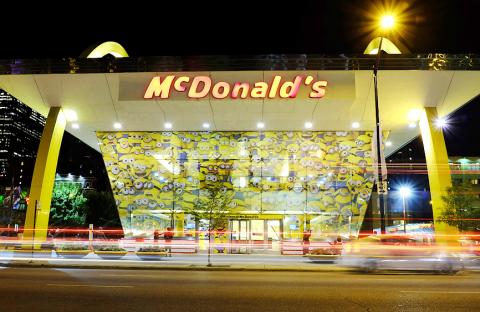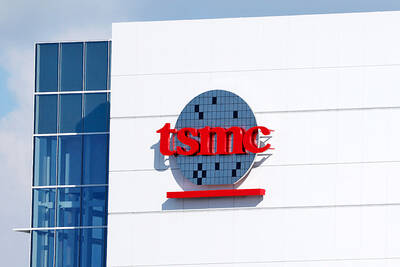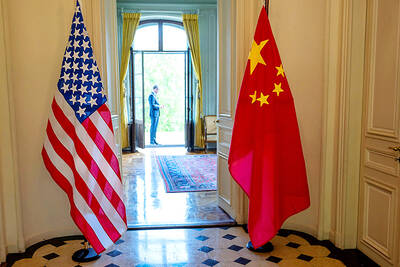McDonald’s Corp swears up and down that the little yellow Minions Happy Meal toy is speaking only nonsense words and not something a little more adult.
Experts said the company might be right, and the curse words many hear might be tied to how our brains are primed to find words even when they are not really there.
The world’s largest hamburger chain on Friday said it does not plan to take the talking Happy Meal toy out of distribution, even though some customers said it sounds like it is cursing.

Photo: AP
A toy bought by reporters made a sound that could be interpreted as the phrase often abbreviated as “WTF.” Another phrase sounded like it could be “Well I’ll be damned.”
The sound quality of the toy makes it hard to say definitively who is right.
The little yellow Minion characters speak a nonsense language and McDonald’s Corp said the Minion Caveman toy makes three sounds — “ha ha ha,” “para la bukay” and “eh eh.”
McDonald’s said in a statement that it had received only a few comments from customers about the toy, which was introduced on July 3.
Nonsense speech sometimes sounds a bit like a real language, and experts said human brains are also wired to look for meaning in noise and images. So people sometimes hear words in gibberish — including words they might think are inappropriate.
The technical name for the phenomenon is pareidolia, hearing sounds or seeing images that seem meaningful, but are actually random. It leads people to see shapes in clouds, a man in the moon or the face of Jesus on a grilled cheese sandwich.
The audio form of pareidolia has been causing confusion for years and years. In the 1960s, the FBI investigated The Kingsmen’s version of the song Louie Louie after concerned citizens complained that the lyrics were obscene.
The band denied it, but hardly anybody could figure out the lyrics, including the FBI.
The agency officially declared the words unintelligible.

Real estate agent and property developer JSL Construction & Development Co (愛山林) led the average compensation rankings among companies listed on the Taiwan Stock Exchange (TWSE) last year, while contract chipmaker Taiwan Semiconductor Manufacturing Co (TSMC, 台積電) finished 14th. JSL Construction paid its employees total average compensation of NT$4.78 million (US$159,701), down 13.5 percent from a year earlier, but still ahead of the most profitable listed tech giants, including TSMC, TWSE data showed. Last year, the average compensation (which includes salary, overtime, bonuses and allowances) paid by TSMC rose 21.6 percent to reach about NT$3.33 million, lifting its ranking by 10 notches

Popular vape brands such as Geek Bar might get more expensive in the US — if you can find them at all. Shipments of vapes from China to the US ground to a near halt last month from a year ago, official data showed, hit by US President Donald Trump’s tariffs and a crackdown on unauthorized e-cigarettes in the world’s biggest market for smoking alternatives. That includes Geek Bar, a brand of flavored vapes that is not authorized to sell in the US, but which had been widely available due to porous import controls. One retailer, who asked not to be named, because

SEASONAL WEAKNESS: The combined revenue of the top 10 foundries fell 5.4%, but rush orders and China’s subsidies partially offset slowing demand Taiwan Semiconductor Manufacturing Co (TSMC, 台積電) further solidified its dominance in the global wafer foundry business in the first quarter of this year, remaining far ahead of its closest rival, Samsung Electronics Co, TrendForce Corp (集邦科技) said yesterday. TSMC posted US$25.52 billion in sales in the January-to-March period, down 5 percent from the previous quarter, but its market share rose from 67.1 percent the previous quarter to 67.6 percent, TrendForce said in a report. While smartphone-related wafer shipments declined in the first quarter due to seasonal factors, solid demand for artificial intelligence (AI) and high-performance computing (HPC) devices and urgent TV-related orders

MINERAL DIPLOMACY: The Chinese commerce ministry said it approved applications for the export of rare earths in a move that could help ease US-China trade tensions Chinese Vice Premier He Lifeng (何立峰) is today to meet a US delegation for talks in the UK, Beijing announced on Saturday amid a fragile truce in the trade dispute between the two powers. He is to visit the UK from yesterday to Friday at the invitation of the British government, the Chinese Ministry of Foreign Affairs said in a statement. He and US representatives are to cochair the first meeting of the US-China economic and trade consultation mechanism, it said. US President Donald Trump on Friday announced that a new round of trade talks with China would start in London beginning today,